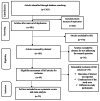Dental caries and mean values of DMFT among children with cerebral palsy: a systematic review and meta-analysis
- PMID: 38360629
- PMCID: PMC10868010
- DOI: 10.1186/s12903-024-03985-5
Dental caries and mean values of DMFT among children with cerebral palsy: a systematic review and meta-analysis
Abstract
Introduction: One of the most prevalent causes of physical disability in children is cerebral palsy (CP), which is a series of complicated neurological disorders. Children with cerebral palsy suffer from multiple problems and potential disabilities, including dental caries. Hence, this study aimed to determine the pooled prevalence of dental caries and mean DMFT (Decayed, Missed, and Filled Permanent Teeth) among children with cerebral palsy in Africa and Asia.
Methods: A comprehensive search of the literature was made to locate relevant studies in PubMed/Medline, HINARI, Web of Science, Science Direct, the Cochrane Library, the Worldwide Science Database, and Google Scholar. The data were extracted in Microsoft Excel and transferred to Stata version 17 software for further analysis. A random-effect model was employed to estimate the pooled prevalence of dental caries and the pooled mean value of DMFT among children with cerebral palsy in Africa and Asia. Heterogeneity between studies was checked using the Cochrane Q test and I2 test statistics. Sub-group analysis by continent was done, and sensitivity analysis was checked. A small study effect was checked using Egger's statistical test at the 5% level of significance.
Results: In this study, 25 original studies conducted in 17 countries in Africa and Asia that fulfilled the eligibility criteria were included in the review. The overall pooled prevalence of dental caries in Africa and Asia among children with cerebral palsy was 55.6% (95% CI: 42.4, 68.8). The pooled prevalence of dental caries among children with cerebral palsy in Africa was 42.43% (95% CI: 30.39, 54.58), and it was slightly higher in Asia with 64% (95% CI: 48.32, 79.72). In the random effect model analysis, the pooled mean DMFT of dental caries in children with cerebral palsy was 2.25 (95% CI: 1.86, 2.64). The pooled mean DMFT in Africa was 1.47 (95% CI: 0.86, 2.09), and in Asia it was 3.01 (95% CI: 2.43, 3.60).
Conclusion: In this study, we found that children with cerebral palsy experienced an alarming rate of dental caries. In these settings, dental caries affected roughly more than half of the children with cerebral palsy. Hence, oral health promotion initiatives should target children with CP, and this group of children must receive early preventive dental care.
Keywords: Africa; Asia; Cerebral palsy; Child; Dental caries; Oral health.
© 2024. The Author(s).
Conflict of interest statement
The authors declare no competing interests.
Figures








Similar articles
-
Water fluoridation for the prevention of dental caries.Cochrane Database Syst Rev. 2024 Oct 4;10(10):CD010856. doi: 10.1002/14651858.CD010856.pub3. Cochrane Database Syst Rev. 2024. PMID: 39362658
-
WITHDRAWN: Community-based population-level interventions for promoting child oral health.Cochrane Database Syst Rev. 2016 Dec 22;12(12):CD009837. doi: 10.1002/14651858.CD009837.pub3. Cochrane Database Syst Rev. 2016. PMID: 28004389 Free PMC article.
-
Water fluoridation for the prevention of dental caries.Cochrane Database Syst Rev. 2015 Jun 18;2015(6):CD010856. doi: 10.1002/14651858.CD010856.pub2. Cochrane Database Syst Rev. 2015. Update in: Cochrane Database Syst Rev. 2024 Oct 4;10:CD010856. doi: 10.1002/14651858.CD010856.pub3. PMID: 26092033 Free PMC article. Updated.
-
Interventions with pregnant women, new mothers and other primary caregivers for preventing early childhood caries.Cochrane Database Syst Rev. 2024 May 16;5(5):CD012155. doi: 10.1002/14651858.CD012155.pub3. Cochrane Database Syst Rev. 2024. PMID: 38753314 Free PMC article.
-
Fluoride gels for preventing dental caries in children and adolescents.Cochrane Database Syst Rev. 2015 Jun 15;2015(6):CD002280. doi: 10.1002/14651858.CD002280.pub2. Cochrane Database Syst Rev. 2015. PMID: 26075879 Free PMC article.
Cited by
-
Evaluation of Systemic Inflammation in Children with Untreated Dental Caries.Oral Health Prev Dent. 2025 Jul 8;23:377-382. doi: 10.3290/j.ohpd.c_2122. Oral Health Prev Dent. 2025. PMID: 40626700 Free PMC article.
-
Alterations in Salivary Parameters, Dental Caries Prevalence and Attitude Towards Oral Hygiene Maintenance Among Children and Adolescents with Metabolic Control of Type 1 Diabetes Mellitus.Indian J Pediatr. 2025 Feb;92(2):205. doi: 10.1007/s12098-024-05341-5. Epub 2024 Nov 29. Indian J Pediatr. 2025. PMID: 39609343 No abstract available.
-
Dental care and services of children and young people with cerebral palsy in Australia: A comprehensive survey of oral health-related quality of life.Spec Care Dentist. 2025 Jan-Feb;45(1):e13098. doi: 10.1111/scd.13098. Spec Care Dentist. 2025. PMID: 39754555 Free PMC article.
References
-
- Shevell MI, Bodensteiner JB, editors. Cerebral palsy: defining the problem. Seminars in pediatric neurology. Elsevier; 2004. - PubMed
-
- Graham HK. Classifying cerebral palsy. J Pediatr Orthop. 2005;25(1):127–8. - PubMed
-
- Parkes J, McCullough N, Madden A. To what extent do children with cerebral palsy participate in everyday life situations? Health Soc Care Commun. 2010;18(3):304–15. - PubMed
Publication types
MeSH terms
LinkOut - more resources
Full Text Sources
Medical
Miscellaneous

